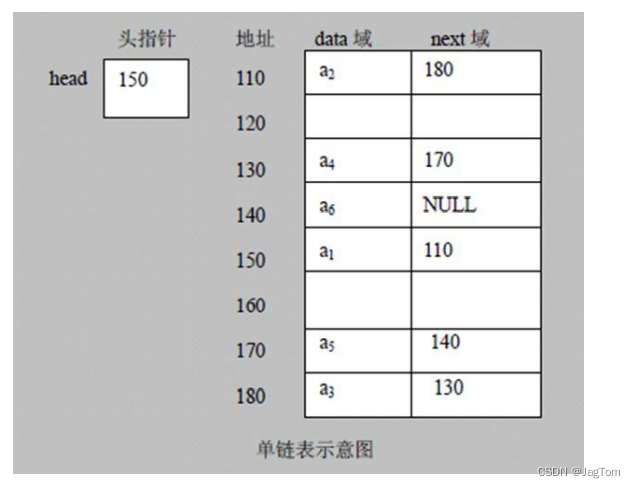首先,我们要知道一个前提,java里面是没有指针的概念的,我们是用对象来模拟指针的
链表的优缺点,为什么要使用链表?
链表是一个动态数据结构,因此它可以在运行时通过分配和取消分配内存来增长和收缩。 因此,无需给出链表的初始大小。(不必初始化大小,动态)
单链表节点的插入和删除非常容易。 与数组不同,在插入或删除元素后,我们不必移动元素。 在链表中,我们只需要更新节点的下一个指针中存在的地址即可。(增删快,查询慢)
由于链表的大小可以在运行时增加或减小,因此不会浪费内存。 在数组的情况下,会浪费大量内存,例如,如果我们声明一个大小为10的数组并在其中仅存储6个元素,那么就会浪费4个元素的空间。 链表中没有这种问题,因为仅在需要时才分配内存。(动态,所用即所用,无内存浪费)
与数组相比,在链表中存储元素需要更多的内存。 因为在链表中,每个节点都包含一个指针,并且它本身需要额外的内存。(对象指针需要额外的内存)
在链表中很难遍历元素或节点。 我们不能像按索引在数组中那样随机访问任何元素.例如,如果我们要访问位置n处的节点,则必须遍历它之前的所有节点.因此,访问节点所需的时间很大.(查询慢)
在链表中,反向遍历确实很困难。 在双链表的情况下,它比较容易,但是向后指针需要额外的内存,因此浪费了内存。
单链表的存储结构:

小结上图:
1)链表是以节点的方式来存储,是链式存储
2)每个节点包含 data 域, next域:指向下一个节点
3)如图:发现链表的各个节点不一定是连续存储
4)链表分带头节点的链表和没有头节点的链表,根据实际的需求来确定
单链表(带头结点)逻辑结构示意图如下

用JAVA代码来实现单链表(带头节点)的增删
public class HeroNodeTest {
public static void main(String[] args) {
HeroNode heroNode1=new HeroNode(1,"小民","大帅哥");
HeroNode heroNode2=new HeroNode(2,"小红","大帅哥2");
SingleNode singleNode=new SingleNode();
singleNode.add(heroNode1);
singleNode.add(heroNode2);
singleNode.list();
}
}
class SingleNode{
//初始化头节点
private final HeroNode head=new HeroNode(0,"","");
//定义添加节点到单向链表的方法
//步骤:不考虑编号的情况下
//1.找到当前链表的最后节点
//2.将最后一个节点的next指向新的节点
public void add(HeroNode heroNode){
//定义一个辅助指针找到末节点
HeroNode temp=head; //从头开始找
while(temp.next!=null){
temp=temp.next; //注意next是节点对象
}
temp.next=heroNode; //将新增的节点添加到最后一个节点的next
}
//遍历列表
public void list(){
if(head.next==null){
System.out.println("链表为空");
}
//定义一个辅助指针找到末节点
HeroNode temp=head; //从头开始找
while ((temp.next!=null)){
System.out.println(temp.next);
temp=temp.next; //节点后移
}
}
}
//节点结构
class HeroNode{
public int no; //data
public String name; //data
public String nickname; //data
public HeroNode next; //用对象模拟指针,来指向下一个节点 next
public HeroNode(int no, String name, String nickname) {
this.no = no;
this.name = name;
this.nickname = nickname;
this.next = next;
}
@Override
public String toString() {
return "HeroNode{" +
"no=" + no +
", name='" + name + '\'' +
", nickname='" + nickname + '\'' +
'}';
}
}HeroNode{no=1, name='小民', nickname='大帅哥'}
HeroNode{no=2, name='小红', nickname='大帅哥2'}
按照编号加入节点
//按顺序添加节点
public void addByOrder(HeroNode heroNode){
//定义一个辅助指针找到末节点
HeroNode temp=head; //从头开始找
boolean flag = false; //标识符
while(true){
if(temp.next==null){
break;
}
if(temp.next.no>heroNode.no){
break;
}
else if(temp.next.no==heroNode.no){
flag=true; //节点已经存在
break;
}
temp=temp.next;//temp后移
}
if(flag){
System.out.println("插入节点已经存在!");
}
else {
heroNode.next=temp.next; //插入节点,节点next指向temp的next
temp.next=heroNode; //temp的next存入节点
}
}删除节点
//删除节点
//单向链表一定要找到删除节点的前一个节点
//被删除的节点不会再被引用,会被JVM自动回收
public void delete(int no){
//定义一个辅助指针找到末节点
HeroNode temp=head;
while (temp.next!=null){
if(temp.next.no==no){
temp.next=temp.next.next;
break;
}
temp=temp.next;
}
}获取节点的个数
//获取节点个数
public int getIndexSum(){
int num=0;
if(head.next==null){
System.out.println("链表为空");
}
//定义一个辅助指针找到末节点
HeroNode temp=head; //从头开始找
while ((temp.next!=null)){
num++;
temp=temp.next; //节点后移
}
return num;
}单链表反转 (剑指offer24)
//反转链表
//方法:头插法
//定义一个新的节点,遍历链表,每次都将链表放到新节点的最前端
public void reverseNode(HeroNode heroNode) {
if (head.next == null || head.next.next == null)
return; //当前链表为空或者链表只有一个节点,无需反转
//定义一个辅助的指针,帮助我们遍历原来的链表
HeroNode temp = head.next;
HeroNode tempNext = null; //指向当前temp节点的下一个节点,相当于一个暂存空间
HeroNode reverseHead = new HeroNode(0, "", "");
//遍历链表,每次遍历的节点放到reverseHead的前端
while (temp != null) {
tempNext=temp.next; //暂存当前节点的下一个节点
temp.next=reverseHead.next;//将原链表的下一个节点指向新的链表的最前端
reverseHead.next=temp;//将原链表的首节点插入到reversHead节点的后面
temp=tempNext; //temp后移
}
head.next=reverseHead.next;
}扩展:双指针迭代法
//迭代法 转自LeetCode
//时间复杂度:O(n),其中 n 是链表的长度。需要遍历链表一次。
//空间复杂度:O(1)。
class Solution {
public ListNode reverseList(ListNode head) {
ListNode prev = null;
ListNode curr = head;
while (curr != null) {
ListNode next = curr.next;
curr.next = prev;
prev = curr;
curr = next;
}
return prev;
}
}
递归法
class Solution {
public ListNode reverseList(ListNode head) {
if (head == null || head.next == null) {
return head;
}
ListNode newHead = reverseList(head.next);
head.next.next = head;
head.next = null;
return newHead;
}
}
从尾到头打印单链表(剑指 Offer 06)
//从尾到头打印单链表,不破坏链表结构
//方法:栈
public void printReverse(HeroNode heroNode){
if(head.next==null){
return; //空链表
}
//创建一个栈
Stack<HeroNode> stack=new Stack<>();
HeroNode temp=head.next;
while (temp!=null){
stack.push(temp); //入栈
temp=temp.next; //节点后移
}
while (stack.size()>0){
System.out.println(stack.pop()); //出栈
}
}再次强调一下,我这里所有的方法都是有自己定义一个虚拟头节点来操作的!!!!
这里我们会发现,我们学过的集合其实就是对链表的一种封装 ,集合底层用到了很多数据结构,这里可以带一下,如List接口中的LinkedList底层就是双向链表,ArrayList是数组。
所以学好数据结构才能知道那些我们常用Api的使用场景和各自的优点。























 2836
2836











 被折叠的 条评论
为什么被折叠?
被折叠的 条评论
为什么被折叠?










